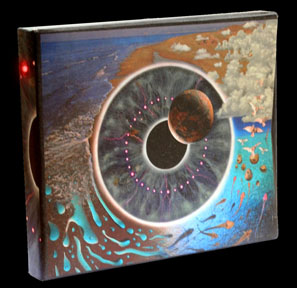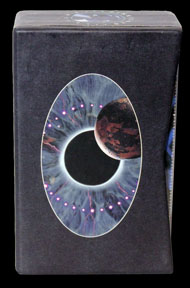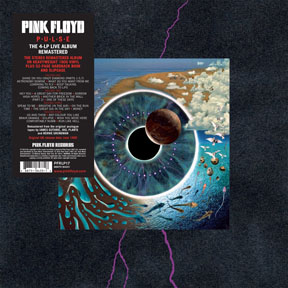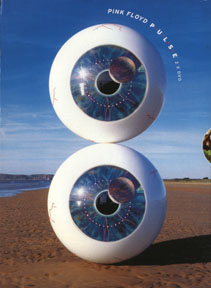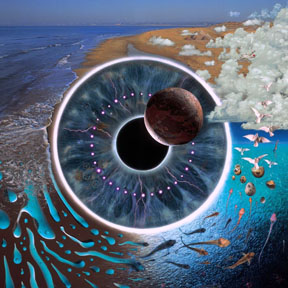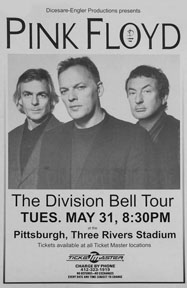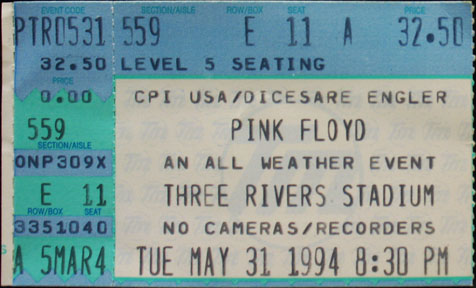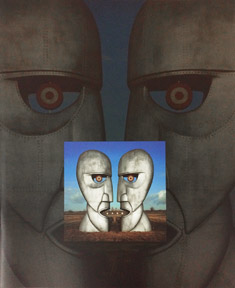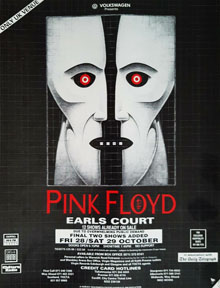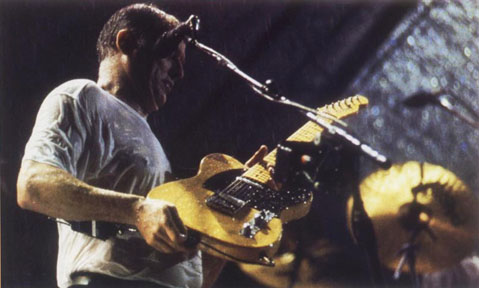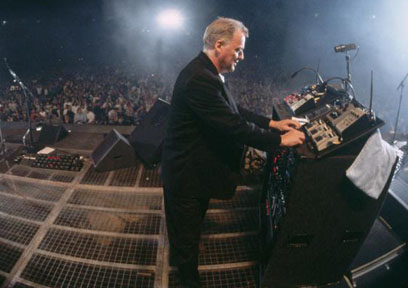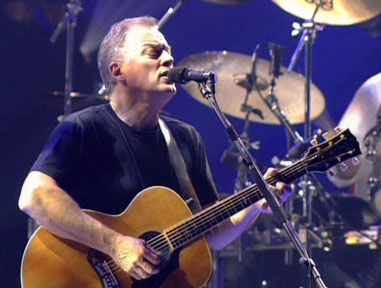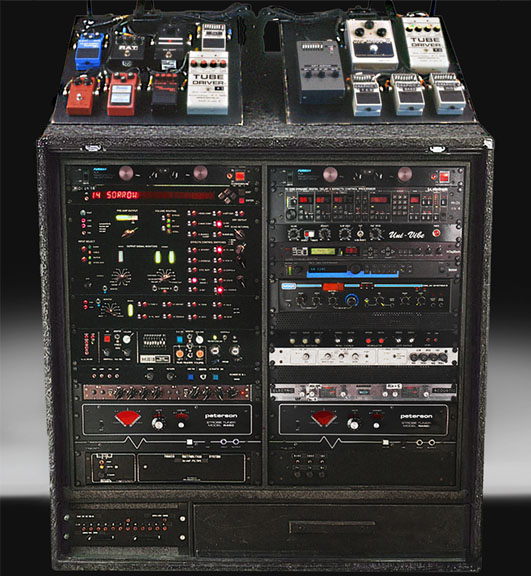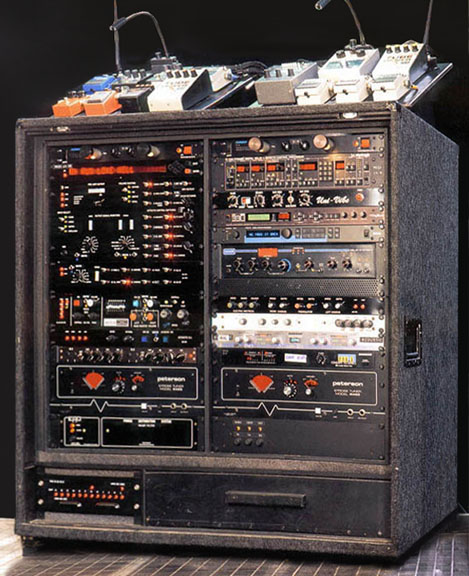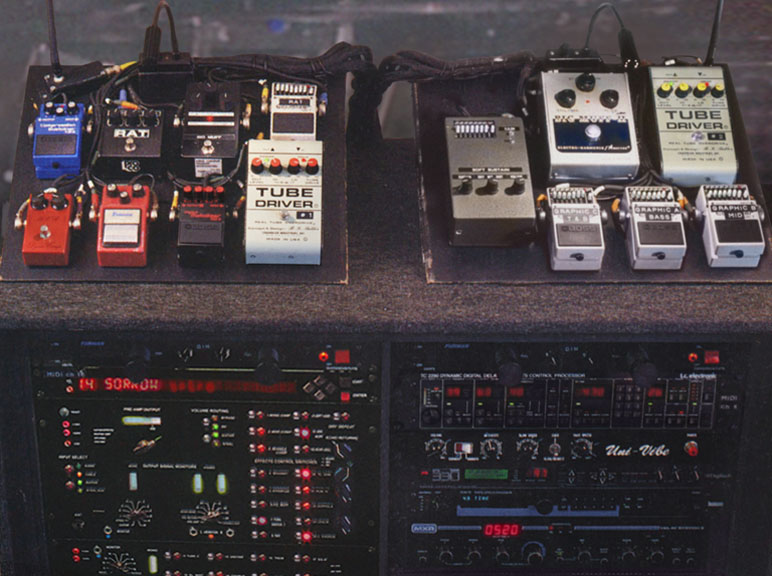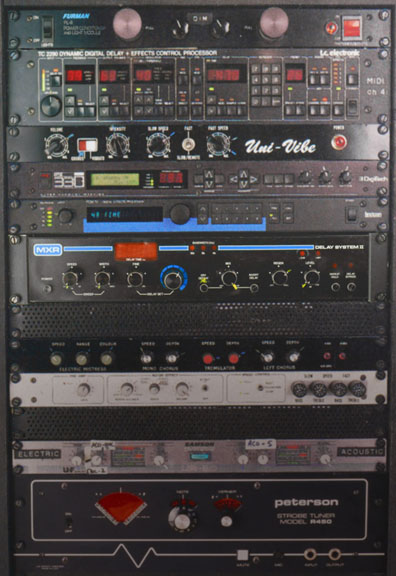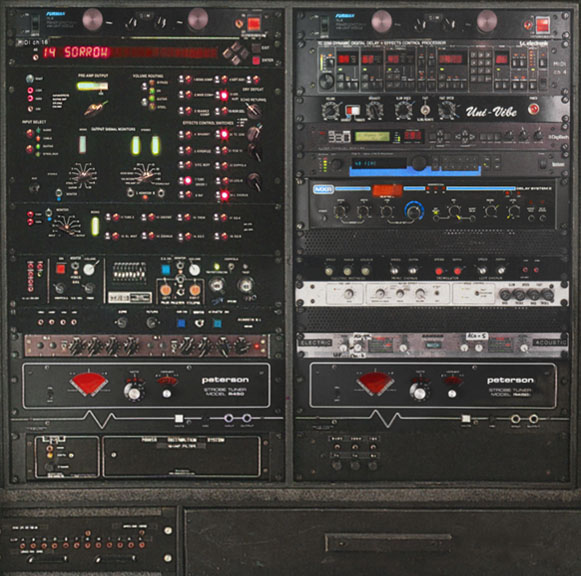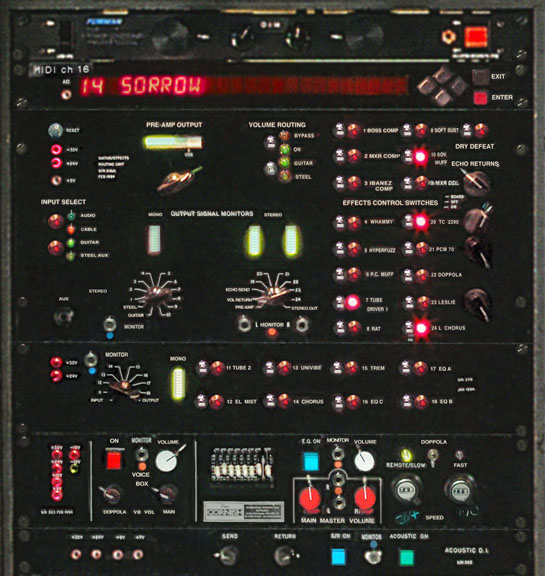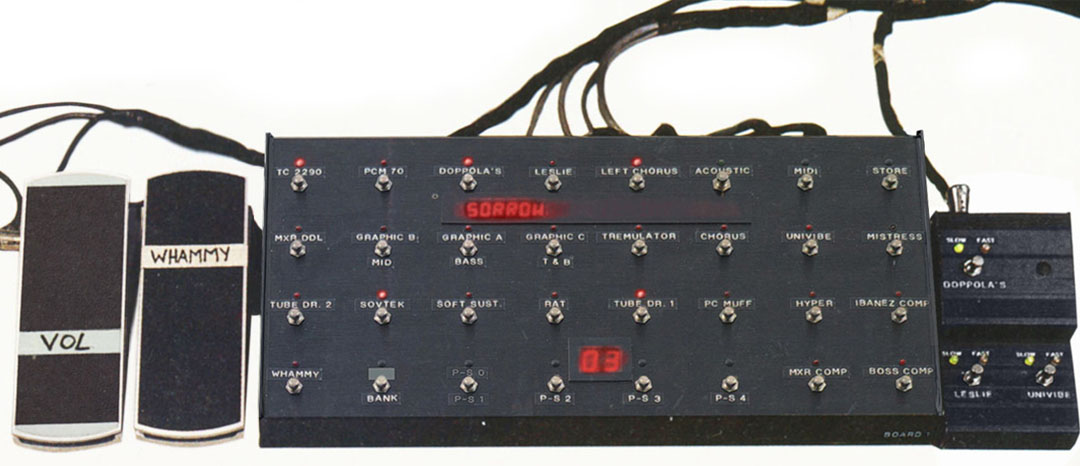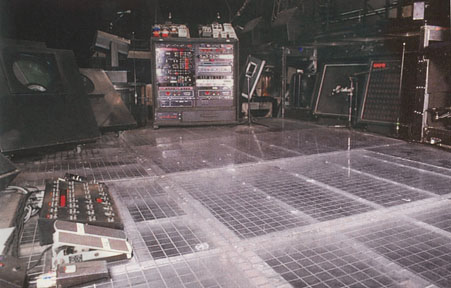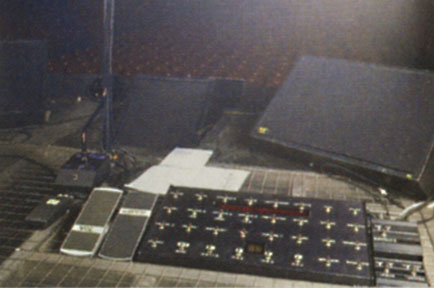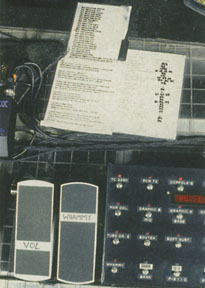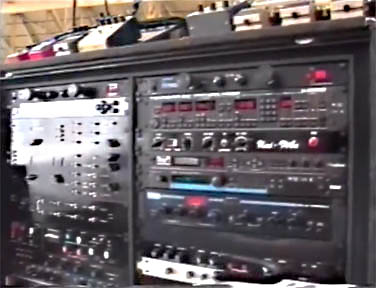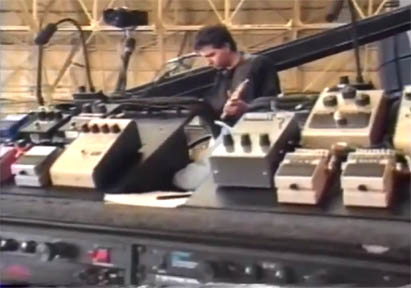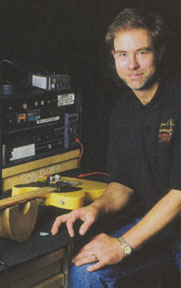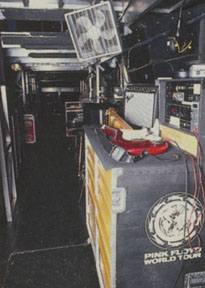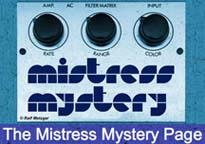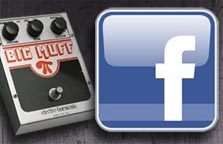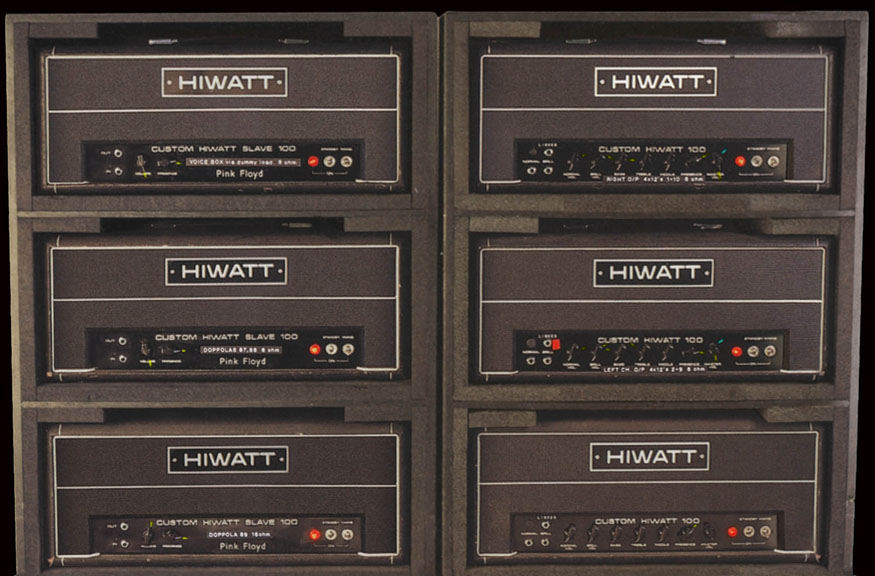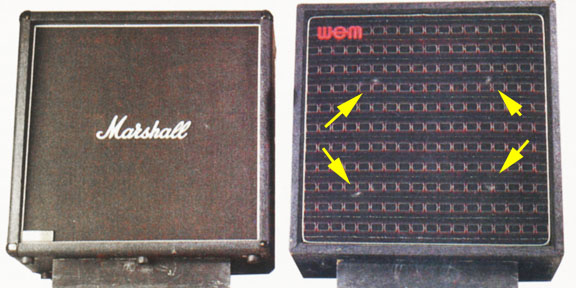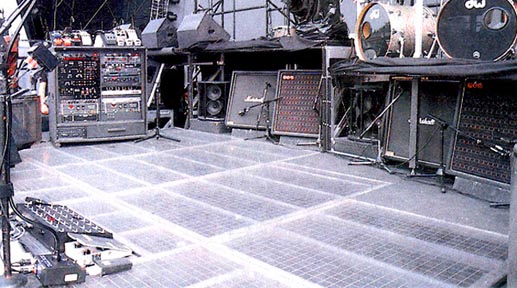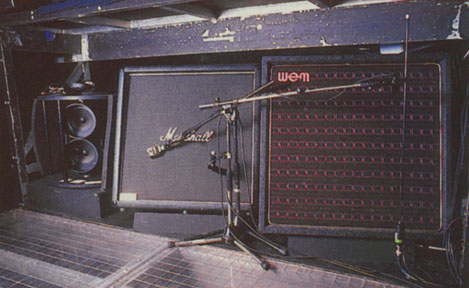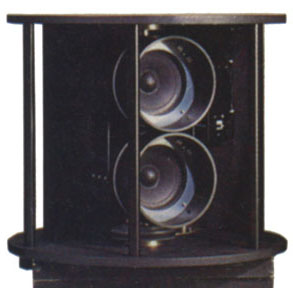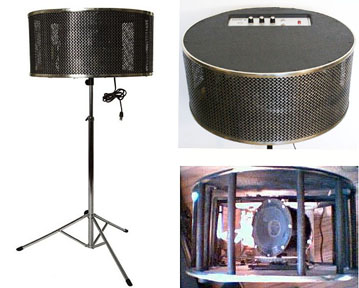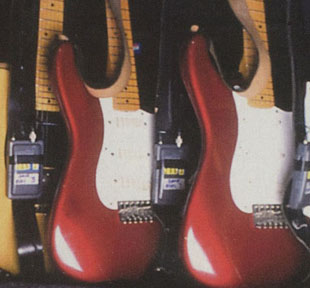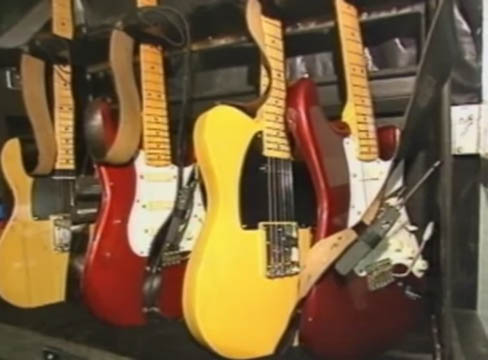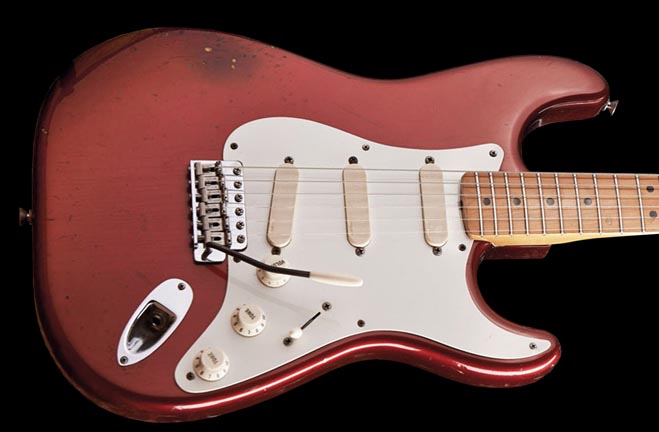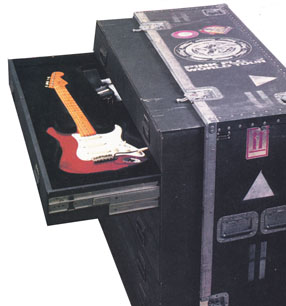NOTE: This website is frequently updated. Last update January 2024.
For effects settings continue to NEXT PAGE
For song-by-song signal chains CLICK HERE
For my setups and sound clips CLICK HERE
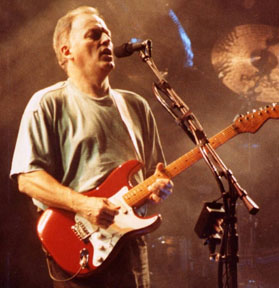
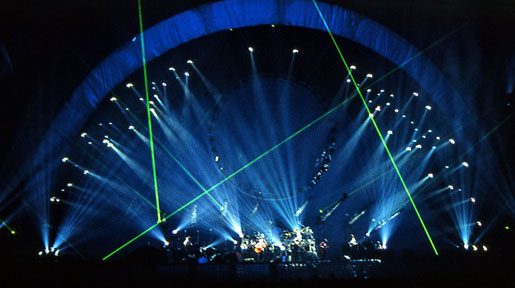
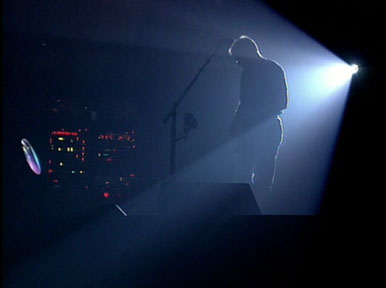
THE 1994 DIVISION BELL TOUR AND PULSE LEAD TONES - From March-October 1994 Pink Floyd performed a massive tour for their Division Bell album which was the highest grossing tour in rock music history at the time. David Gilmour's playing was spectacular and his live tones from the tour were arguably his most popular in the post Roger Waters version of the band, and possibly his most famous among Gilmour fans. David's massive live rig used on this tour was also one of the most talked about guitar rigs among Pink Floyd gear heads. I have tried to be as comprehensive here as possible, but there is also some very detailed info about David's 1994 rig and gear used can be found at The Tone from Heaven website and Gilmourish.com. There is also a lot of good information in the January 1995 edition of Guitarist magazine, the July 1995 issue of Guitarist Magazine, and the December 1996 edition of Guitar Shop magazine.
The Division Bell tour was chronicled with the popular Pulse live album CD / cassette / vinyl and VHS / Laser Disk concert video released in 1995, which featured the first live release of Dark Side of the Moon by the band, not performed it in its entirety since the 1970s. 10 concerts at various venues in Europe were recorded, along with another 10 at Earl's Court. The Pulse album was mixed from twelve different concerts recorded in August, September and October of 1994.
The October 20th 1994 concert at Earl's Court was broadcast live on satellite television and Pay Per View on Dutch and French tv channels. It was rebroadcast again in November on BBC1 with additional sound mixing and some editing to fix mistakes during the performance, like removing a bad note David played just before the Syd's Theme section of Shine On and some mistakes in Comfortably Numb. The VHS / Laser Disk video of Pulse was a further reedited version of the televised broadcast, with remixed sound and some different camera angles. As I recall, some guitar solos were shortened, including Sorrow and about 3 minutes of Comfortably Numb. In 2006 the Pulse video was rereleased in a remastered DVD format with some additional video reediting. In December 2019 Pulse was released on Blu Ray in The Later Years boxed set with some additional video editing. The vinyl album version was rereleased in remastered form in 2018.
The original CD edition featured a blinking red "heartbeat" LED in the case, something unique at the time. I remember every few years asking my father and other friends who owned the CD if their LED still blinked. Mine stayed blinking for about seven years!
CD, cassette, vinyl, and DVD cover art for the various releases of Pulse
I was fortunate to be able to attend two Pink Floyd concerts in May 1994. One was just a few rows from center stage of Vanderbilt Stadium in Nashville, Tennessee, with a clear view of David and the band. A few weeks after that my father and I saw them at Three Rivers Stadium in Pittsburgh, PA, near the rear of the stadium. Those gave me two completely different perspectives of the spectacle of the stage show and David's sound. Both were incredible experiences, but very different from each other. I still clearly remember things like David's guitar swirling in quadraphonic sound around Three Rivers Stadium for the Sorrow intro, Money solos, and the long intro to Run Like Hell. I also remember David pitching notes up and down using a Whammy pedal during the On the Turning Away solo in Pittsburgh, the giant bouncing inflatable Pigs atop the massive speaker towers on both sides of the stage, which seemed to leap out and deflate at the end of One of These Days, and the heated shockwave of air and sound that hit me when the pyro cannons went off at the end of Run Like Hell in Nashville. The cannons were so loud that my ears were still ringing on the drive home!
Tour poster, ticket stub, and tour program book from Pink Floyds Three Rivers Stadium concert in Pittsburgh PA, May 1994. (right) Earls Court poster
Overall, the band sounded much better live in 1994 and on Pulse than the 1988 tour and Delicate Sound of Thunder live album, but I actually prefer David's 1988 guitar tones much more than in '94. I noticed the difference immediately when I heard him in '94. In Pittsburgh I was up in the nosebleed seats with a great view of the lightshow, and the huge stadium acoustics made the Big Muff and Tube Drivers sound very similar to what I heard later on Pulse. The Big Muff and Tube Driver tones were much thinner than Pulse in the Nashville concert. I was much closer to the stage and PA speakers, and I could clearly hear the odd, gurgly-wet doppler sound of the Doppola rotating speakers in the guitar solos. During the intro and outro to Sorrow the Doppolas sounded like someone sawing, which you can also hear on Pulse, although Pulse had the Doppolas much lower in the mix than what I heard live.
Most of David's live tones remained relatively the same throughout the tour, based on official releases and bootlegs, but David changed his sound for the Earl's Court concerts that were recorded in September and October and released as Pulse. The primary change was the level of the doppola rotary speakers in the mix. They were very dominant earlier in the tour but were reduced slightly for the Earls Court concerts. But there was an even bigger change for the October 20th soundboard mix heard in the live broadcast, PPV broadcast, and BBC rebroadcast. The doppolas were almost completely removed. You could hear them in the front-of-house audience mix, as evident in the audience recordings, but they were barely in the broadcast soundboard mix. What the audience actually heard in Earls Court that night was much more doppola heavy, which gave David's guitar a different tone. Below is a sound clip comparing the October 20th live broadcast mix from the soundboard, with an audience recording of the same concert.
![]() Comfortably Numb - radio broadcast (first) compared to audience recording (second)
Comfortably Numb - radio broadcast (first) compared to audience recording (second)
The Pulse version was remixed even more, so it did not even sound the same as those live broadcasts. Below is a comparison of the BBC rebroadcast version and the same performance remixed for Pulse. The guitar in Pulse is much thinner sounding, the midrange has been boosted, and the doppolas have been reduced even more in the mix than what they were in the live broadcast.
![]() Comfortably Numb - BBC radio broadcast (first) compared to Pulse version (second)
Comfortably Numb - BBC radio broadcast (first) compared to Pulse version (second)
Pulse is not a very good representation of what David's guitar actually sounded like on the '94 tour, but there are several very good audience recordings that did capture that sound accurately. The best one to hear what David's rig sounded like directly from his speaker cabinets is the September 13, 1994 concert at Stadio Delle Alpi in Torino, Italy, recorded directly from the soundboard. A good place to find that and other 1994 audience recordings is Yeeshkul.com.
Below is a comparison of that September 1994 recording in Italy compared to the October performance of Comfortably Numb from Pulse. The doppola rotary speakers are much heaver in the Torino concert.
![]() Comfortably Numb - comparison of a soundboard recording from September 13, 1994 in Torino, Italy compared to the Pulse album mix, recorded October 20th 1994.
Comfortably Numb - comparison of a soundboard recording from September 13, 1994 in Torino, Italy compared to the Pulse album mix, recorded October 20th 1994.
Below is a sound clip comparing the live soundboard recording from Rotterdam, September 4th 1994 (from a television promo) with the Pulse mix.
![]() Comfortably Numb first solo - Rotterdam soundboard/tv promo (first) compared to Pulse (second)
Comfortably Numb first solo - Rotterdam soundboard/tv promo (first) compared to Pulse (second)
David Gilmour on stage in 1994
THE DIVISION BELL TOUR RIG - This rig originated as a Custom Audio Electronics (CAE) effects rig built for Pink Floyd's Momentary Lapse of Reason tour in 1987 by Bob Bradshaw. There were problems with that rig so it was later completely overhauled and modified by Pete Cornish in 1990 for Pink Floyd's Kenbworth Park performance, then again by Cornish prior to Pink Floyd's 1994 Division Bell tour.
Like the AMLOR system, this version was also a stereo system. It included a pedalboard with David's selected compression, overdrive, distortion, and equalizer pedals. They were a mixture of old and new effects and two custom made Pete Cornish pedals. Most of them had power supply and impedance matching modifications made by Pete Cornish to improve the signal-to-noise ratio. Below the pedalboard was a 24 loop effects routing system switcher and David's rack mounted modulation and delay effects, including a custom rack mounted Uni-vibe and a custom modulation effects rack. The mono effects on David's pedalboard were sent to three stereo delays, then mixed down to a single stereo pair in a mixer, then to a stereo rotary speaker simulator. The left and right channels were then sent to a pair of Hiwatt amplifiers, with the signal split to another pair of Hiwatts powering David rotating speaker cabinets, and then to a third Hiwatt for his Heil talk box.
Also in the rack section was the preamp for the whole system (Alembic F2-B), two power conditioners (Furman PL-8), two tuners (Peterson R450 Stobe Tuners), and a dual UHF wireless reciever (Samson UR-5D) for David's acoustic and electic guitars.
It is not clear who made the two custom rack units containing the Uni-vibe and modulations. Gilmour's backline tech and right hand man, Phil Taylor, stated he had the Uni-vibe built into a rack, and a 1996 article implies Phil made the modulation rack, calling it a Phil Taylor Custom Rack. The 9v and 18v fuse LEDs on the modulation rack are the same type as on the Cornish routing system, so it was likely Pete Cornish built them.
The design concept was to achieve a user friendly system with the cleanest possible audio signal, using the highest quality components between guitar and amp to eliminate hums, buzzes, RF interference, etc...he (Gilmour) likes to have his rack onstage with him every night and the reason why his pedals are mounted on top is so that he can wander over and give them a tweak as he feels necessary. - Phil Taylor, Gilmour's backline tech, Guitarist magazine January 1995
Dave's guitar sound continued to be processed from his own rack, and we didn't really have to do anything to it at front of house - 1994 Sound Mixing Engineer Andy Jackson from Sound on Stage #7, 1997
On that big Pink Floyd set-up we've got 24 loops, but when they're off it's as if the pedals aren't there...It (each loop) has an input buffer so it doesn't change the sound when you kick in the loop. - Pete Cornish
All of the effects were controlled by a CAE midi floor switch board through the custom Pete Cornish routing system. The routing system was built with 24 buffered send/return loops, all controlled by the CAE switchboard at David's feet, which was modified by Cornish to work with his routing system. This system allowed David to switch on pre-programmed patches of specific effects for specific songs, turn each individual effect on or off at any time, as well as control the master volumes for his Heil Talk Box, 4x12 speaker cabinets, and Doppola rotating speaker cabinets.
Gilmour's massive Pete Cornish rack system and pedal board used for Pink Floyd's 1994 tour. Left photo shows settings for the song High Hopes and right photo shows settings for Run Like Hell
Gilmour's pedal board with Cornish effects routing system under it showing the settings for Time (left photo) and Gilmour's rack effects (right photo)
Pedalboard Effects:
Left Side, Top Row - Boss CS-2 Compressor, ProCo Rat, Pete Cornish P-2 (labeled Big Muff), Boss GE-7 (EQ for RAT)
Left Side, Bottom Row - MXR Dynacomp (original Script w/LED and DC jack mods), Ibanez CP-9 Compressor/Limiter, Boss MZ-2 Digital Metalizer, BK Butler/Chandler Tube Driver #1
Right Side, Top Row - Pete Cornish SS-2 Soft Sustain with built in Boss GE-7 EQ, Sovtek Big Muff Pi (Civil War), BK Butler/Chandler Tube Driver #1
Right Side - Bottom Row - Bos GE-7 Graphic EQ C (treble and bass), Bos GE-7 Graphic EQ A (Bass), Bos GE-7 Graphic EQ B (Mid)
Rack Effects from top to bottom:
• TC. Electronics TC-2290 Digital Delay
• Uni-Vibe in custom rack enclosure
• DigiTech IPS 33B Super Harmony Pitch Shifter (used for Whammy octave effect with foot pedal)
• Lexicon PCM-70 effects processor
• MXR Digital Delay System II
• Custom Effects Rack with the following built in effects:
- Electric Mistress,
- Boss CE-2 chorus (mono)
- Demeter Tremulator
- Boss CE-2 (left channel)
• Dynacord CLS-222 Leslie Simulator
(left photo) Gilmour's 1994 rack effects and Pete Cornish effects routing system, showing settings for the song High Hopes.
(right photo) A close up of the Effects Routing System used to program and monitor all of the pedalboard and rack effects, talk box, and Doppola speaker cabinets.
Settings show the effects used for the solo in the song Sorrow. Note the switch/LED labeled Huperfuzz is actually a Boss MZ-2.
On Left is an Ernie Ball volume pedal (modified with a 10k pot to reduce high end loss) and an EB expression pedal to control the Digitech Whammy (IPS 33B rack unit).
In the middle is Gilmour's CAE/Bradshaw midi floor switcher, used to select programmed effect patches through the effects routing system or turn individual effects on/off manually.
The effect-on LEDs show the effects patch used for the solo in the song Sorrow. On the right is a fast/slow speed switch for the Doppola rotating speaker cabinets,
speed switch for the Dynacord Leslie Simulator, and speed switch for the Uni-vibe. Note the switch/LED labeled Huperfuzz is actually a Boss MZ-2
Gilmour's stage setup for the Earl's Court concerts in October 1994
(left photo) Gilmour's rack effects. (middle photo) Phil Taylor, Pink Floyd's trusted backline and gear tech since 1974, seen behind the pedalboard setting up the rig with guitar in hand.
(right photos) Phil Taylor and his work station under the 1994 Pink Floyd tour stage. Phil is David's his right hand man and the person in charge of setting up and maintaining all of his gear.
AMPLIFIERS - As with Pink Floyd's Knebworth 1990 concert, the same Custom Hiwatt AP100s (DR103) with the preamp stages bypassed were again used, along with a modified Alembic F2-B bass preamp (Fender Twin/Showman style preamp). According to the signal chain diagram, the signal from the effects rack went into the F2-B preamp, then to David's on-stage volume pedal, then into his delays, then into a master routing unit with stereo sends to two Hiwatt AP100 amplifiers. One was used for left channel and one for the right. These "all purpose" Hiwatts were modified in 1990 so the preamps and tone stages could be bypassed. Only the Presence Control and Master Volumes were used to control the power amplification stages, and the master volumes were set to maximum. One Hiwatt powered a set of WEM and Marhsall 4x12 speaker cabinets for the right channel and the other powered a duplicate set of speaker cabs for the left channel, with a chorus added. A third Hiwatt AP100 was in the rig as a spare. There were also three Custom 100 Hiwatt Slave amps, one for the left Doppolas, one for the right Doppolas, and one connected to a dummy load box and David's Heil voice box used for the song Keep Talking.
He likes his initial signal to be very clean. To achieve this he uses a mid-Seventies Alembic F2-B bass preamp and the power stage of six 100-watt Hiwatt heads. The Alembic F2-B is a very straightforward unit -- it has a bright switch, volume, bass, middle and treble controls. We, however, have altered it just a little bit…we lowered the impedance in the output and changed the capacitor in the bottom end to eliminate some of the lows, because it was very boomy through closed-back cabinets. His stage speaker system consists of two WEM 4x12's with Fane Crescendo speakers, two Marshall 4x12's and three custom-made rotating speaker cabinets we call "doppolas"…He operates several master volume pedals: one for his 4x12 cabinets, another one for his rotating speakers, another for his voice box and a speed control for the doppolas - Phil Taylor, Guitar World Sept 1994
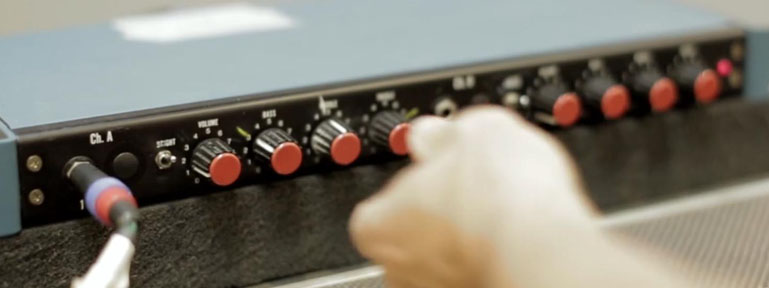
One of David's Alembic F2-B preamps, modified by Pete Cornish
Using the Alembic F2-B preamp as the master preamp for the whole rig was something unique to both the 1990 and 1994 Pink Floyd rigs, but it was never used this way after that. David had been using an F2-B in front of his Yamaha RA-200 rotating speaker cabinets since the late 1970s, but in 1990 he decided to try it in place of his Hiwatt preamps. According to Pete Cornish, David decided he no longer liked the EQ of the Hiwatt tone stack and prefered the F2-B. In essence, Pete merged the Fender tone stack with a Hiwatt power amp, but with some modifications to make it work better with the 1990 rig and with the closed back speaker cabinets being used. David wanted to boost the mid range above the maximum stock range, more like the Hiwatt tone stack, and cut the bass below the minimum stock range, so Pete was asked to make several modifications to the F2-B in 1990, prior to Pink Floyd's Knebworth performance. He changed the F2-B bright switch to an upper mid range boost (photos show this was switched off for the tour) and modified the mid range control to allow more mids at the top end of the pot sweep. He also changed a capacitor to reduce the low bass frequencies to make the sound less boomy through David's four closed-back 4x12 speaker cabinets. The front inputs were also moved to the back side to work in the rack system better. He also made several mods to bring the F2-B up to current signal voltage and impedance standards - adding a master volume control for each channel on the back to lower the output, and adding a ground lift transformer to lower the impedance on the outputs.


This modified Alembic F2-B preamp was used as the master preamp for the whole rig. Only one channel was used. Tick marks show David's settings.
Note the Bass was set to minimum and the Mids to maximum. The master volume on the back was set to maximum according to Pete Cornish.
David's three Custom Hiwatt AP100 amplifiers with preamps bypassed, and three Slave 100 amp heads, all used for the 1994 tour
SPEAKERS, CABINETS, and MICROPHONES - For the main speaker cabinets David used a combination of WEM and Marshall 4x12" cabs in stereo. For the right channel there was a WEM Super Starfinder 4x12" cab with Fane Crescendo speakers and Marshal 4x12" cab with Celestion speakers. The left channel had duplicate WEM and Marhsall cabs. The Celestions helped balance out the bright mid range sound of the Crescendo speakers. The Marshall cabs appear to be 1980s era JCM 800 Lead-1960 straight 4x12 cabs, and are likely the same Marshall cabs David was using in the 1980s. The exact model of Celestion speaker was never mentioned in interviews, but in 2006 David used 75 Watt Celestions in one of his WEM cabs, so that may be what he used in '94 as well. Those were likely the 1980s G12T-75 or the more mid-scooped G12T-75 speakers used in mid 1990s. David also used the Crescendos/Celestion mix again for his 2015-2016 tour. According to Phil Taylor, one WEM 4x12 cab in that rig was loaded with Crescendos and one was loaded Celestion G12-100 speakers.
"I've got three normal Hiwatt heads, AP100s…One Hiwatt powers a WEM 4x12 with the Fane Crescendos in it and a Marshall with Celestions; the second does the same thing but it has a chorused version of the first signal‚ in effect, this means that one pair has a wet signal and the other remains dry." - Phil Taylor, Guitarist Magazine Jan 1995
Sound Engineer Andy Jackson said (in Sound on Stage #7, 1997) that he used updated versions of the small, square Sennheiser mics for the speaker cabinets (e906), and a regular Shure SM58 for David's vocals. He said initially he had four mics up, one on each of the four cabinets in the stereo rig, but ended up trimming it down to two mics because they did the job just as well and there was less to go wrong. However, photos from the tour show the left Marshall cab with two speakers miked (one Sure SM57 and one e906) and the left WEM cab with one speaker miked (SM57). The right Marshall had one speaker miked (SM57) and right WEM two two miked (one Sure SM57 and one e906).
Marshall JCM-800 Lead-1960 speaker cab loaded with Celestion speakers and WEM Starfinder 4x12 cab loaded with Fane Crescendo 100w speakers.
Note the aluminum dust caps visible through the grille cloth, indicating these are Crescendo 12 'A' type speakers.
Gilmour's on-stage speaker cabs in October 1994 (left to right) Doppola rotating speaker cabinets, Marshall JCM-800 4x12 speaker cabinets, and WEM 4x12 cabinets
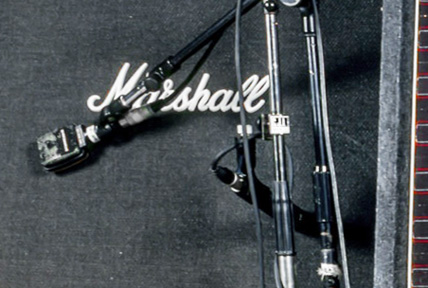
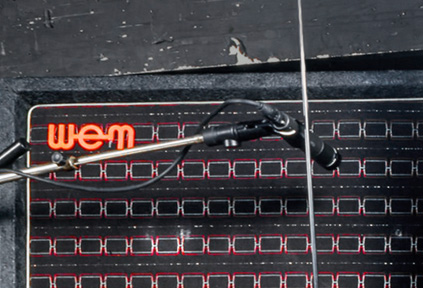
The left Marshall was miked with a Sennheiser e906 microphone and Sure SM57. The left WEM was miked with a single Sure SM57.
The speaker cabs on the right side were miked the opposite way, with an SM57 on the Marshall and SM57 + e906 on the WEM.
DOPPOLAS - For David's heavy modulation effect heard in the live concerts he used three custom made Doppola rotating speaker cabinets, running in stereo. They were designed by David's backline tech Phil Taylor and built by Paul Leader, based on one of David's favorite rotary effects, the RO-1 Mastero Rover rotating speaker cabinet. The Rover, made by Gibson in 1972, had a single 6" 35w speaker inside that spun on an axle to create the warbly doppler sound effect, an adjustable speed knob, and a built in amplifier. The rotation speed could be controlled by a foot pedal and went from zero to twenty revolutions per second. About 3/4 of the cabinet was open. For the 1993 Division Bell studio recordings David used a stereo rig that included a combination of Hiwat SA212 and Fender Bassman amps in each channel, with the Rover mixed in. A switch on the Rover allowed only the higher frequencies to be routed through the rotating speaker and lower frequencies to a regular amp, but it is not known if David did this.
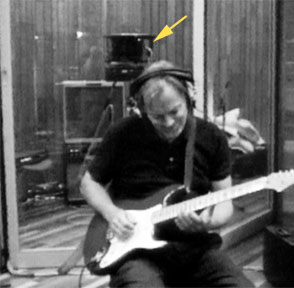
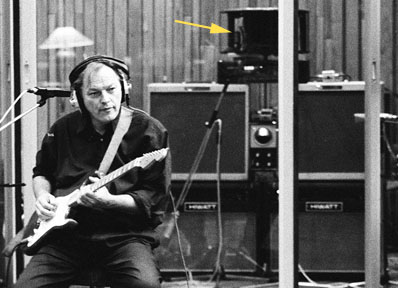
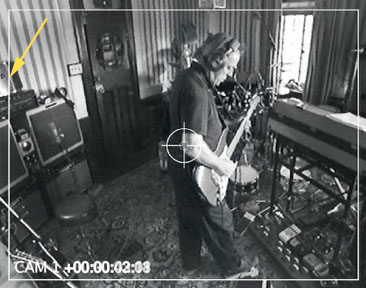
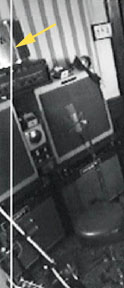
David's Hiwatt and Bassman stacks with the Mastro Rover on top from the Olympic Studios (left) sessions and Astoria sessions (right)
The Doppolas were a more powerful version of the Rover, but in a speaker cabinet form only. There was no built in amplifier. Each Doppola had two stacked 6" 100w speakers spinning on an axle and adjustable fast/slow speed controls. About half the speaker cabinet of each was open. One Hiwatt powered two 8ohm Doppolas running at different speeds, presumably for one channel, and one Hiwatt powered a 16ohm Doppola for the other channel. Combined they created a similar chorus/flange-like doppler effect as David's Maestro Rover and Yamaha RA-200 rotary speaker cabinets, but in stereo. They were nearly always on and blended with the sound from David's 4x12 speaker cabinets. He could adjust the Doppola volume on stage from his rack effects rig, and the fast/slow rotation speed from his floor switcher.
We powered the two Doppolas with HiWatts and tried out a number of different drivers to see what would handle the power and sounded the most like a guitar speaker. David had the Doppolas switched on throughout the whole show and they were blended into his 4 x 12-inch mix at various points during the set when some movement was required. - Phil Taylor, March 1997 Sound On Stage
We have three on them on stage which are used continually in conjunction with the 4x12s - Phil Taylor, January 1995 Guitarist
If you were fortunate enough to attend one of the 1994 Pink Floyd concerts prior to the Earl's Court shows, you definitely heard them. You can also hear them clearly in many of the bootleg recordings of the '94 tour. For some reason, David decided to reduce the effect in the Earl's Court concerts recorded for the Pulse live album and video mix. They were also reduced in the mix of the original Earl's Court live broadcast from October 20th, '94. Perhaps David felt that a 2-channel stereo representation of that sound did not work quite as well as what it actually sounded like in the concert arenas. Having attempted to record rotating speakers myself, I know that recordings are a completely different experience than what it sounds like when you are actually there. The only way to effectively reproduce that sound is with a quadrophonic or surround sound system.
(left photo) one of Gilmour's three Doppola rotating speaker cabinets with 10" speakers, designed by Phil Taylor and Paul Leader and built by Paul.
(right photo) A 1970s Maestro Rover RO-1 rotating speaker cabinet, which the Doppolas were based on.
GUITARS - David's main Fender Stratocaster for the tour was his candy apple red '57 reissue, purchased in 1984. In 1985 it was fitted with EMG-SA noiseless pickups (custom routed in 1988 to seat deeper into the pickup cavities), SPC and EXG controls replaced the tone controls, and the tremolo arm was shortened to fit into David's palm when he played. The same mods were also made to a spare red '57 reissue Strat, once owned by Mick Ralphs of Bad Company. Both were strung with GHS .010”-.048” strings and fitted with four tremolo springs. To help the guitars stay in tune when using the tremolo bar, especially for the deep dives in the song Sorrow, David tightened down the six bridge plate screws as far as they could go so that side of the plate had contact with the guitar. David also used a cream colored spare '57 reissue.
He uses a customized set of GHS Boomers. The gauges are .010, .012, .016, .028, .038 and .048. For his acoustic guitars he uses Ernie Ball Earthwood light gauge strings - Phil Taylor, Guitar World Sept 1994
As far as the actual spring setup of my trems, sometimes I have three, sometimes four (three in the studio, four on stage). Then I adjust the tremolo up until it feels right with my gauge of strings and everything else. I don’t find that I have too much trouble with it going out of tune either - David Gilmour, Guitar Shop December 1996
David used two butterscotch colored 1952 American Vintage Reissue Fender Telecasters with a slim C-shaped maple necks and ash bodies. One was tuned to standard for Astronomy Domine and one was tuned drop D for Run Like Hell. These were the same Telecaster David used for the Momentary Lapse of Reason tour in 1987-89.
For slide guitars David used a red Jedson lap steel tuned to Open Em (EBEGBE) and a blonde Fender Deluxe lap steel tuned to Open G (DGDGBE). The Jedson, a clone of the Fender lap steel, was purchased in the 1970s and used on Pink Floyd tours. It was modified with an EMG-H pickup (confirmed in the Their Mortal Remains book), an SPC control (presumed), and two switches. The EMG-H was a single coil pickup in humbucker sized housing, similar to the EMG-SA, but with a ceramic magnet instead of alnico. The difference is slightly less midrange than the SA model. I am not sure what the two switches control, but the one labeled MID possibly switches the SPC control in and out of the circuit and the other possibly switches the battery out of the circuit to prevent it from being drained when not in use. The Jedson had also been modified to add a Roland Hex synthesizer pickup, installed behind the EMG pickup. A large cavity was routed out to the right if the output jack to house the electronics for the Hex pickup, so the two switches may have originated as controls for it and are now inactive. The Hex was removed prior to the 1987 tour, leaving an empty cavity. It was later filled and the paint refinished prior to David's 2006 On an Island tour.
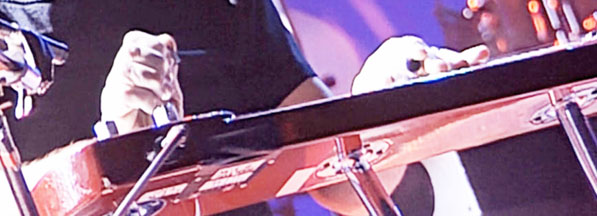
For acoustics David used two rare Gibson J-200 Celebritys made in 1984/85 (he owns three). One was tuned to DADGAD for Poles Apart and one was in standard tuning. He also used a Gibson Chet Atkins electro-classical with nylon strings for High Hopes. All the acoustic had Crown and EMG pickups installed, each with a separate output jack.
DAVID'S SPC SETTINGS - See this page for for photos and settings from various songs for David's EMG controls, specifically the SPC control on his EMG fitted Strats. In general, David set the SPC control around 4-5 when playing high gain solos and on 10 for some of his big solos like Sorrow and the second Comfortably Numb solo. For clean solos or solos with a light overdrive he did not use the SPC. He never used the EXG control.
David's spare red Strat was originally purchased by Mick Ralphs when he was the backup guitarist for David's 1984 tour. When they were performing in New York in May 1984, David and Mick went guitar shopping at Mannys music store. Mick found a red Strat he liked, almost the same as David's red '57 reissue. Mick purchased it, but David wished he had seen it first. Years later in 1993 Phil Taylor was in Chandler's (Chandler Guitars in the U.K.) looking at guitars for Gilmour's upcoming Division Bell tour. He spotted a similar red Strat for sale, which turned out to be the exact same one owned by Mick, so he bought it as a backup.
Shown above - (left photo) Gilmour's '52 reissue Telecaster with ash body tuned to drop-D, Gilmour's '57 reissue Red Strat, a backup Red Strat,
and a butterscotch colored '52 reissue Telecaster in standard. (right photo) Gilmour's main Red Strat from 2016.
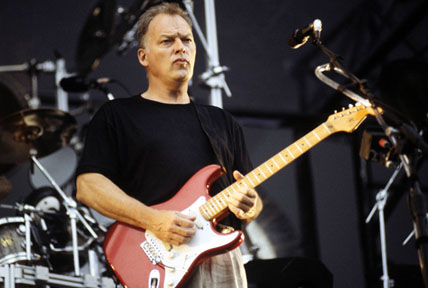
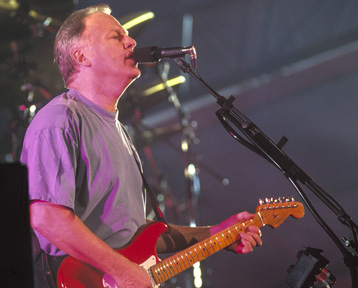
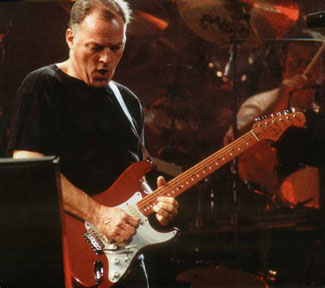
(shown above) Gilmour playing his main '57 reissue Red Stratocaster loaded with EMG-SA pickups, SPC control, and fitted with a shortened tremolo arm
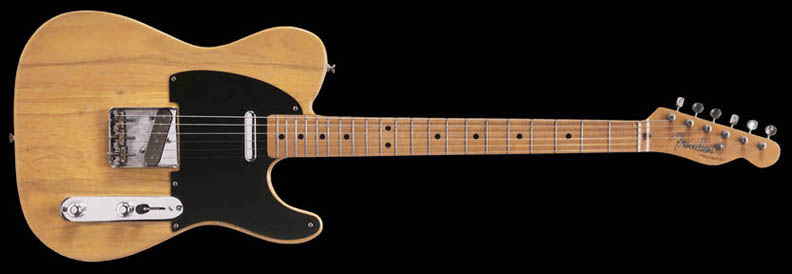
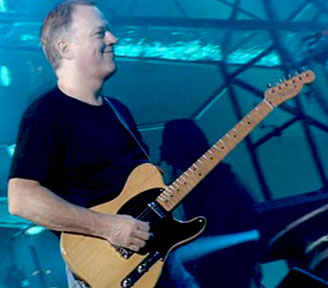
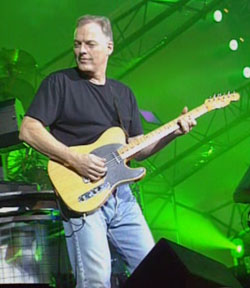

Gilmour playing the drop-D tuned 52V reissue 1952 Telecaster with maple neck and ash body for Run Like Hell
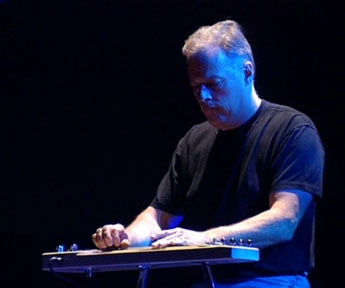
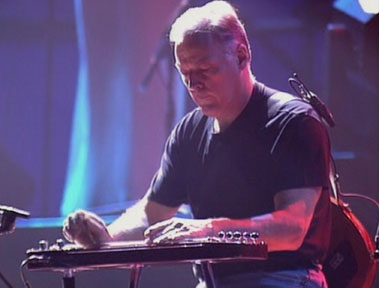
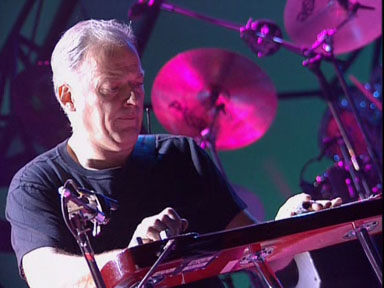
(left to right) Gilmour playing his blonde Fender Deluxe lap steel slide guitar tuned to Open G (DGDGBE) on Great Gig in the Sky, and Gilmour playing High Hopes on his red Jedson lap steel
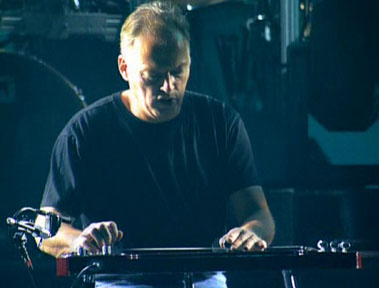
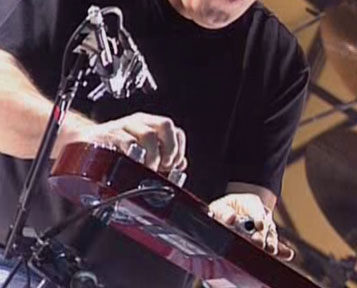
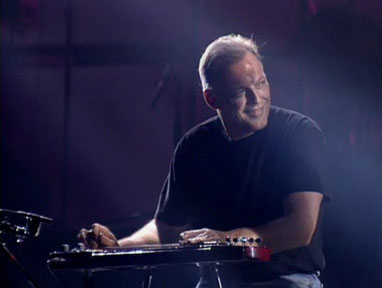
Gilmour playing One of These Days on his red Jedson lap steel tuned to open Em (EBEGBE)
Shown above - (left photo) Gilmour playing a rare Gibson J-200 Celebrity. (middle photo) Gilmour's Chet Atkins electro-classical acoustic guitar and two Gibson J-200 Celebrity acoustics.
(right photo) Gilmour's custom electric guitar case with drawers for each guitar
Kit’s Secret Guitar, Gear, and Music Page
Guitar stuff, gear stuff, soundclips, videos, Gilmour/Pink Floyd stuff, photos and other goodies.
Copyright Kit Rae.
VISIT MY SWORDS, KNIVES and FANTASY ART WEBSITE www.kitrae.net

